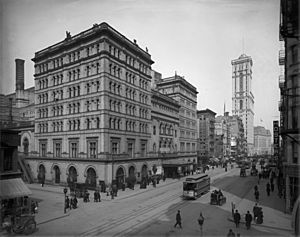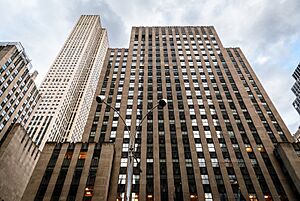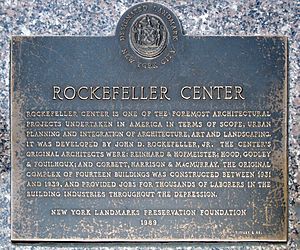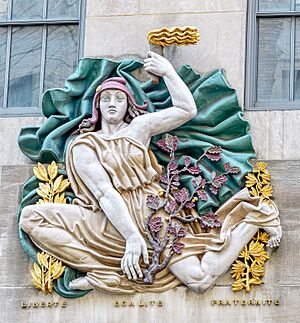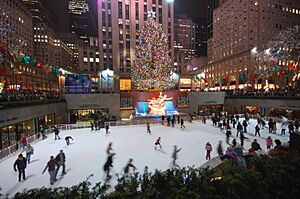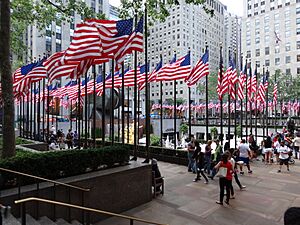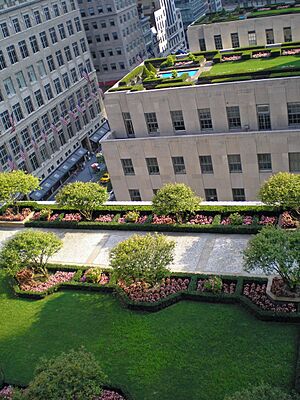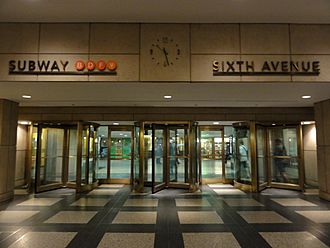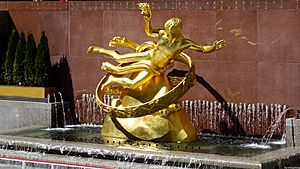Rockefeller Center facts for kids
|
Rockefeller Center
|
|
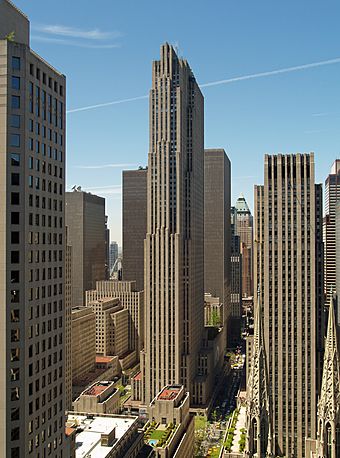
View from the northeast of 30 Rockefeller Plaza at the heart of the complex
|
|
| Location | Manhattan, New York |
|---|---|
| Nearest city | New York City |
| Area | 22 acres (8.9 ha) |
| Built | 1930–1939 |
| Architect | Raymond Hood |
| Architectural style | Modern, Art Deco |
| NRHP reference No. | 87002591 |
Quick facts for kids Significant dates |
|
| Added to NRHP | December 23, 1987 |
| Designated NHL | December 23, 1987 |
Rockefeller Center is a group of 19 large buildings in Midtown Manhattan, New York City. It covers about 22 acres (9 hectares) between 48th and 51st Streets. The first 14 buildings were built in the Art Deco style. They were ordered by the powerful Rockefeller family. These buildings stretch between Fifth Avenue and Sixth Avenue. They are separated by a large sunken area and a private street called Rockefeller Plaza. Later, more buildings were added, including some in the modern International Style.
The land for Rockefeller Center was owned by Columbia University. In 1928, they leased it to John D. Rockefeller Jr.. He was the main person who made the complex happen. At first, the plan was to build a new opera house for the Metropolitan Opera. But the opera company couldn't afford it. So, the plans changed, and the current Rockefeller Center began to take shape. Construction started in 1931, and the main part was finished by 1939. Rockefeller Center is seen as one of the biggest building projects from the Great Depression era. It became a special landmark in New York City in 1985 and a national landmark in 1987. Today, the complex is managed by Tishman Speyer.
The original center has different parts. The "Radio City" area, along Sixth Avenue, includes 30 Rockefeller Plaza and Radio City Music Hall. It was built for RCA's radio businesses, like NBC. The "International Complex" along Fifth Avenue was made for companies from other countries. The complex is famous for its many artworks, its large underground area, its ice-skating rink, and the yearly lighting of the Rockefeller Center Christmas Tree.
Contents
The Story of Rockefeller Center
How Rockefeller Center Began
The land where Rockefeller Center stands was first a public botanical garden called the Elgin Botanic Garden. This was in the early 1800s. Later, in 1823, Columbia University bought the land.
In 1926, the Metropolitan Opera wanted a new building. By 1928, architects were hired to design it. But the opera couldn't pay for the new building by itself. So, John D. Rockefeller Jr. stepped in to help. Columbia University leased the land to Rockefeller for 87 years. The cost to buy the space and build new buildings was estimated at $250 million.
Rockefeller hired a group of architects called "Associated Architects." They worked together so no single firm got all the credit. Raymond Hood, a fan of Art Deco style, was the main architect.
Plans Change: From Opera to Media Center
After the stock market crash of 1929, the Metropolitan Opera couldn't afford to move. So, on December 6, 1929, the opera plans were canceled. Rockefeller quickly talked with RCA (Radio Corporation of America) and its companies, NBC and RKO Pictures. They decided to build a huge entertainment center for mass media instead. By May 1930, RCA and its partners agreed to the idea.
The design of the complex was shaped by a 1916 rule. This rule said that tall buildings in New York City needed to have "setbacks." This meant parts of the building had to be built further back as they went higher. This helped more sunlight reach the streets. The new plan also included gardens on the roofs and a sunken central plaza.
At first, people called the project "Radio City" or "Metropolitan Square." But Ivy Lee, the Rockefeller family's public relations advisor, suggested "Rockefeller Center." John Rockefeller Jr. didn't want his family name on a business project. But he was convinced that the name would attract more tenants. The name was officially changed in December 1931. Over time, "Radio City" came to mean only the western part of the complex, especially Radio City Music Hall.
Building Rockefeller Center
To build the center, 228 buildings were torn down. About 4,000 people living there had to move. Demolition started in 1930. By August 1931, all the building leases were bought. However, some people on the edges of the land refused to leave. So, Rockefeller Center was built around their properties.
Digging for the Sixth Avenue side began in July 1931. Construction on the first buildings, Radio City Music Hall and the Center Theatre, started later that year. A huge amount of Indiana Limestone was ordered for the project. It was the largest order of its kind at the time.
The RKO Building was the first to be finished in September 1932. The Music Hall opened in December 1932. The RCA Building (now 30 Rockefeller Plaza) opened in May 1933. A new street, Rockefeller Plaza, was built in stages from 1933 to 1937. The famous Rockefeller Center Christmas Tree was put up for the first time in December 1933. The complex's Prometheus statue was finished in May 1934. By July 1934, 80% of the space in the six open buildings was rented.

Work on two more international-themed buildings and a larger "International Building" began in September 1934. One of the small buildings was rented to Italian businesses. The other was meant for Germany, but Rockefeller decided against it in 1934 due to the rise of Nazism. This empty space became the "International Building North." It was rented by different international companies. In April 1935, the International Building and its wings opened.
The underground walkways and ramps were finished in early May 1935. In 1936, an ice rink was put in the lower plaza. It replaced shops that weren't making money.
The 36-story Time & Life Building was finished in November 1936. By 1937, eleven buildings were done, costing over $100 million. A building for Associated Press was finished by December 1938. The presence of Associated Press and Time Inc. made Rockefeller Center a hub for both radio and print media.
The construction of Rockefeller Center created jobs for 40,000 to 60,000 people. It was the largest private building project of its time. By fall 1939, the complex had 26,000 tenants and 125,000 visitors every day.
Rockefeller Center During World War II
Even before the U.S. joined World War II in 1941, the war affected Rockefeller Center. Some international tenants had to leave. After the attack on Pearl Harbor in December 1941, Rockefeller Center ended leases with German, Italian, and Japanese tenants. This was because their countries were part of the Axis powers. Art that seemed fascist was removed. During the war, a room in the RCA Building (30 Rockefeller Plaza) became a secret office for British Intelligence.
Rockefeller Center only started making a profit after all the original buildings were finished. By 1941, it was almost fully rented. By 1944, 99.7% of its space was leased. The complex became very popular. Lines to enter Radio City Music Hall stretched for blocks.
Because of its success, John Rockefeller Jr. gave ownership of the complex to his sons. By 1953, the complex was making $5 million a year in profit.
Growing Bigger After the War
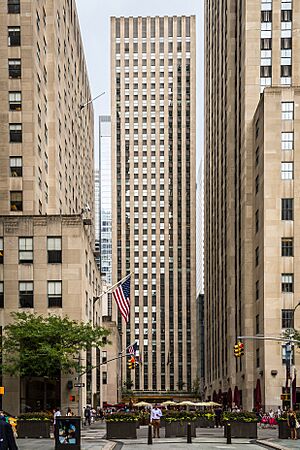
Rockefeller Center started planning to expand during World War II. In 1943, they bought more land nearby. In 1944, they announced plans to expand to the southwest and north.
Esso (now Exxon) wanted more space. In February 1947, the new Esso Building became part of Rockefeller Center.
Some tenants, like Sinclair Oil Corporation, wanted to leave because the original buildings didn't have air conditioning. Newer buildings did. Columbia University, who still owned the land, was asked to install air conditioning.
In 1949, a church near the complex was leased and later torn down. This made way for 600 Fifth Avenue, which opened in 1952. The Sinclair Oil Company became a main tenant there. The small Center Theatre was not used much anymore. In 1954, it was torn down to expand 1230 Avenue of the Americas.
Time-Life also needed more space. In 1956, a new Time-Life Building was announced. It would be on the west side of Sixth Avenue. This new building, 1271 Avenue of the Americas, opened in December 1959.

In 1963, 600 Fifth Avenue officially became part of Rockefeller Center. That same year, Esso (later Exxon) wanted another new building. Rockefeller Center hired architects to design three new towers on the west side of Sixth Avenue. These included the Exxon Building (1251 Avenue of the Americas), the McGraw-Hill Building (1221 Avenue of the Americas), and the Celanese Building (1211 Avenue of the Americas). These new buildings opened between 1971 and 1974. By then, Rockefeller Center held 7% of all the office space in Manhattan.
1970s and 1980s: Landmark Status
In the early 1970s, 600 Fifth Avenue and 75 Rockefeller Plaza were renovated. In 1973, Rockefeller Center Inc. renewed its lease on the complex.
By the late 1970s, Radio City Music Hall was losing money. People started a campaign to save it. In March 1978, the New York City Landmarks Preservation Commission made the theater a city landmark. It was also listed on the National Register of Historic Places. The Music Hall was saved from closing.
In 1982, a report said Rockefeller Center was almost always fully rented. The New York City Landmarks Preservation Commission held meetings in 1983 to decide how much of Rockefeller Center should be protected as a landmark. The Rockefeller family wanted only a small part protected. But most others wanted the whole complex to be a landmark. On April 23, 1985, the commission made the outside of all the original buildings landmarks. They also protected the lobbies of the International Building and 30 Rockefeller Plaza. Two years later, the buildings became a National Historic Landmark.
Columbia University wasn't making enough money from the leases by the 1970s. So, in 1983, they decided to sell the land under Rockefeller Center. In 1985, Columbia sold the land to the Rockefeller Group for $400 million. The Rockefeller Group then started to update the complex. The Rainbow Room restaurant was closed for a big renovation and reopened in December 1987. In 1988, the RCA Building was renamed the GE Building. In 1989, a Japanese company, Mitsubishi Estate Co., bought the Rockefeller Group.
1990s to Today
In 1995, the Rockefeller Group had financial problems. In 1996, David Rockefeller (John Jr.'s son) and a group of investors bought Rockefeller Center's buildings for $1.1 billion. Before the sale was even finished, they sold a large part of 30 Rockefeller Plaza to NBC.
In 2000, Tishman Speyer bought the original 14 buildings and the land for $1.85 billion. With this sale, the Rockefeller family no longer owned a part of Rockefeller Center's daily operations. Tishman Speyer also decided to update the shops and underground areas. The Rainbow Room closed again in 2009 for more renovations and reopened in 2014. In 2015, the GE Building was renamed the Comcast Building.
In 2020, Tishman Speyer planned to renovate the Channel Gardens, Rockefeller Plaza, and the Lower Plaza. These plans were approved. A rooftop garden above Radio City Music Hall opened in September 2021. Starting in 2022, a roller rink called Flipper's Roller Boogie Palace was set up in the Lower Plaza during spring and summer. Many new restaurants also opened in Rockefeller Center. In 2023, there were plans to turn some upper floors of 10 Rockefeller Plaza into a hotel.
Buildings of Rockefeller Center
Rockefeller Center today has two main groups of buildings and one separate building. There are 13 original Art Deco office buildings from the 1930s. There's also one building from 1947 across 51st Street. Plus, there are four modern-style towers built along the west side of Avenue of the Americas in the 1960s and 1970s. The whole center covers 22 acres (9 hectares) and has about 17 million square feet (1.6 million square meters) of office space.
Original Landmark Buildings
The original landmark buildings cover 12 acres (4.9 hectares) in Midtown. They are between Fifth and Sixth avenues, from 48th to 51st streets. These buildings were all built together. They have been owned by Tishman Speyer since 2000. A key feature of these buildings is their Indiana limestone outside, as planned from the start. All 14 buildings were designed by the Associated Architects, with Raymond Hood as the main architect. They are all listed on the National Register of Historic Places.
Radio City Area Buildings
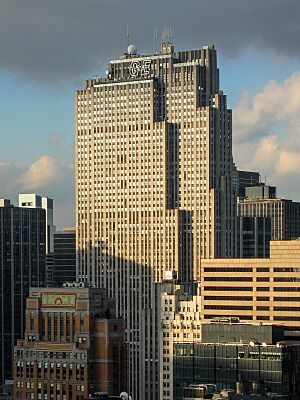
The east side of Sixth Avenue is called "Radio City." It has most of the buildings made for the radio complex. These include 1230 Avenue of the Americas, 30 Rockefeller Plaza, Radio City Music Hall, and 1270 Avenue of the Americas. The idea for a combined media center came in 1920.
The building at 1230 Avenue of the Americas is on the western part of the southernmost block. It was the last building in the original complex to be finished in November 1939. It's 23 stories tall with two 7-story wings. It was later renamed the Simon & Schuster Building.
The Center Theatre, at 1236 Sixth Avenue, was the only original building to be torn down. It was first called the "RKO Roxy Theatre." It had 3,700 seats. It showed movies, musicals, ice-skating shows, and television. But it was too similar to the larger Radio City Music Hall. It was replaced in 1954 by an expansion of 1230 Avenue of the Americas.
The block north of that, between 49th and 50th streets, has 30 Rockefeller Plaza. This 70-story building is 872 feet (266 m) tall. It is the main building of the whole complex. It opened in 1933 as the RCA Building. It was later renamed the GE Building and then the Comcast Building. 30 Rockefeller Plaza has three parts: the tall tower with the famous Rainbow Room restaurant, a windowless part for NBC Studios, and a shorter 16-story tower. Its limestone outside and Gothic-inspired designs influenced the look of the other buildings.

Radio City Music Hall is at 1260 Avenue of the Americas. It's the only theater left in the complex. It opened in December 1932. The Music Hall is 121 feet (37 m) high and seats 6,000 people. Over 300 million people have visited it since it opened.
The RKO Building, at 1270 Avenue of the Americas, is a 31-story building. It was built over the Music Hall and shares many of its outside details. Construction started in 1931 and finished in September 1932. The building's entrance has three sculptures by Robert Garrison. The RKO Building was later renamed for the American Metal Climax Company (AMAX).
International Complex Buildings

The International Complex is along Fifth Avenue. It has the 41-story International Building and four smaller buildings with themes from different countries. These smaller buildings were planned after an earlier oval-shaped building idea was canceled. The low, rectangular buildings were thought to look better on Fifth Avenue. The international theme came about because not enough American companies wanted to rent space there. Eventually, British, French, and Italian businesses moved in.
All four smaller buildings look similar from the outside. They have limestone walls, roof gardens, and shops on the ground floor. But their artworks are different. The Channel Gardens separate the British Empire Building and La Maison Francaise.
The southernmost of the four buildings is La Maison Francaise (meaning "the French House") at 610 Fifth Avenue. It opened in October 1933. It's a six-story building with a limestone front. Across the Channel Gardens is its twin, the British Empire Building at 620 Fifth Avenue. It opened in April 1933 and looks just like La Maison Francaise.
The 512-foot (156 m) tall International Building is at 630 Fifth Avenue or 45 Rockefeller Plaza. It's 41 stories high. It was built very quickly, in just 136 days. The building has a central plaza on its east side, facing Fifth Avenue. This plaza has the famous statue of Atlas. The Palazzo d'Italia and International Building North are six-story retail wings of the International Building.
Other Original Buildings
The 36-story tower at 1 Rockefeller Plaza was the original Time & Life Building. It opened in April 1937. It was later renamed for General Dynamics and then simply by its address.
10 Rockefeller Plaza is across from 1 Rockefeller Plaza. It was planned as the Holland House, but the Dutch government didn't sign on. So, it became the Eastern Air Lines Building. It's a 16-story building. It has a six-story parking garage, the first in Rockefeller Center. Today, it's home to the Today Show studios and the Nintendo New York store.
50 Rockefeller Plaza, once the Associated Press Building, is between 50th and 51st streets. It was built in 1938. This 15-story building is unique because it fills its entire lot. This was to give the Associated Press a large, open newsroom.
600 Fifth Avenue is at the corner of Fifth Avenue and 48th Street. It was built after the other main buildings, opening in 1952. It was also known as the Sinclair Oil Building. It has a limestone front, like the original complex. Its ground floor had only one public entrance to make more space for shops.
Newer Buildings Added Later
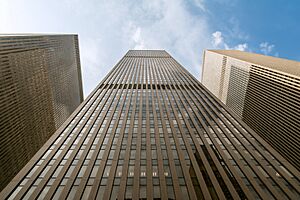
The buildings added later are owned by different companies. The first one was 75 Rockefeller Plaza, built in 1947 at 51st Street. It was originally called the Esso Building. It was the headquarters for Standard Oil Company of New Jersey (later Exxon). It's now owned by the estate of Mohamed Al Fayed and managed by RXR Realty.
The other four buildings were built as one big project on the west side of Sixth Avenue, from 47th to 51st streets. They were built between 1958 and 1974. This $300 million project aimed to attract big companies like Celanese Corporation, McGraw-Hill, Exxon, and Time Inc. These new buildings added a lot of office space to the center. The four buildings are:
- 1211 Avenue of the Americas, the former Celanese Building. It's 592 feet (180 m) tall and opened in 1974. It's now the News Corp Building.
- 1221 Avenue of the Americas, the former McGraw-Hill Building. It's 674 feet (205 m) tall and opened in 1973.
- 1251 Avenue of the Americas, the former Exxon Building. This 750-foot (230 m) tall building was built from 1967 to 1971. Exxon's main offices moved here in 1972.
- 1271 Avenue of the Americas, the former Time & Life Building. This 587-foot (179 m) tall building was finished in 1958.
Special Features of Rockefeller Center

The Lower Plaza
The Lower Plaza is in the very center of the complex, below ground level. It was part of the original plans for the opera house. Even though the opera house was canceled, the plaza stayed. It was first planned to be oval-shaped but later became rectangular. It was planted with shrubs, making it feel private.
The main way to enter the plaza is through the Channel Gardens. This is a 60-foot (18 m) wide, 200-foot (61 m) long walkway with plants. It runs west from Fifth Avenue, between the British Empire Building and La Maison Francaise. The walkway has six narrow pools with fountains. The fountains have designs of sea creatures. In winter, the fountains are turned off, and angel sculptures are placed there. At the west end of the walkway, there's a plaque about the old Elgin Gardens. Steps lead down to the ice rink.
The western end of the plaza has Paul Manship's 1934 statue, Prometheus. The statue is 18 feet (5.5 m) high. It shows the Greek god Prometheus bringing fire to humans. The Rockefeller Center Christmas Tree is placed above the statue every year from November to January. The first tree was put up in 1934. Over time, it became a famous tradition.
Most of the plaza's outdoor area is an ice rink. It was put in in 1936. It was meant to be temporary but became very popular. In 1939, a permanent 120 by 60 foot (37 by 18 m) rink was installed.
About 200 flagpoles surround the plaza at ground level. They were put up in 1942. They originally showed the flags of the United Nations' member countries. Later, they also showed flags of U.S. states or seasonal designs. On holidays, every pole flies the flag of the United States.
In 1962, a plaque was placed at the plaza. It lists ten principles that John Rockefeller Jr. believed in. These include "the supreme worth of the individual" and "truth and justice are fundamental."
The architect I. M. Pei called Rockefeller Center's lower plaza "perhaps the most successful open space in the United States." It has inspired similar places around the world.
Rockefeller Plaza Street
Rockefeller Plaza is a private street that runs through the complex. It's parallel to Fifth and Sixth avenues. This street was part of the original plans for the opera house. Only the 720-foot (220 m) section between 48th and 51st streets was built. The road was fully open by 1937. It was named "Rockefeller Plaza" in 1933. It helps connect all the different parts of Rockefeller Center.
Rockefeller Plaza is 30 feet (9.1 m) wide. But its sidewalks are much wider than on normal streets. Underneath the street, there's a multi-level steel structure. This holds the underground mall, storage rooms, and the complex's shipping center. Since it's private property, the plaza is closed for part of one day each year.
Rooftop Gardens
The gardens on Rockefeller Center's roofs were designed by Ralph Hancock and Raymond Hood. They thought rooftop gardens would make the complex more beautiful. Originally, the gardens were supposed to be connected by bridges between the buildings. But this plan didn't fully happen. Gardens were installed on 10 Rockefeller Plaza, 30 Rockefeller Plaza, the four International-themed retail buildings, the Center Theatre, and Radio City Music Hall.
The biggest garden was the 0.75-acre (0.30 ha) "Garden of the Nations" on the eleventh-floor roof of 30 Rockefeller Plaza. It opened in April 1935. It had different gardens inspired by countries around the world. It also had a "rock garden" with a stream and many plants. The Garden of the Nations attracted many visitors. But eventually, the nation-themed gardens were removed.
The gardens on the International complex buildings did better. The British and French buildings have gardens with a lawn and pool. The other two gardens have ivy lawns. These roof gardens were restored in the 1980s.
In 2021, plans for a 24,000-square-foot (2,200 m²) rooftop terrace on Radio City Music Hall were submitted. This garden, called Radio Park, opened in September 2021. It has birch trees, bleachers, and pathways.
Underground Concourse
A network of underground passages with shops and restaurants runs from 47th to 51st streets. This underground system was part of the 1931 plan. It was meant to be over 0.75 miles (1.21 km) long, air-conditioned, and full of shops.
The underground mall with 25 shops opened in May 1935. In 1999, the complex's owner, Tishman Speyer, renovated the concourse. They wanted to make the shops more noticeable and attract fancier stores. They replaced old decorations, added air-conditioning, and updated the shops.
The concourse is the top level of the complex's four basement levels. It's the only one open to the public. The lower levels are for storage and shipping. You can get to the concourse from building lobbies, restaurants around the ice rink, and elevators. There's also a connection to the New York City Subway's 47th–50th Streets–Rockefeller Center station.
Buildings That Stayed
Two small buildings are next to the 30 Rockefeller Plaza annex. These buildings exist because their owners refused to sell their land during construction. A grocer named John F. Maxwell wouldn't sell his property until 1970. Also, the owners of a speakeasy, Daniel Hurley and Patrick Daly, refused to sell their property for $250 million. They kept leasing their land until 1975. Rockefeller Center was built around these properties.
On the southeast corner of the complex, on Fifth Avenue, there were two other existing buildings. One was developed as 608 Fifth Avenue. The St. Nicholas Church also refused to sell its property. The church was torn down in 1949 to make way for 600 Fifth Avenue.
Art at Rockefeller Center
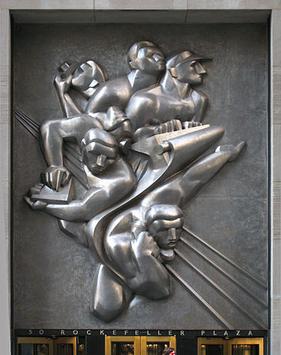
In 1931, a plan was made to put special artworks in each building. Hartley Burr Alexander, a professor of mythology, was in charge of this. He suggested sculptures, statues, murals, fountains, and mosaics. He also wanted rooftop gardens on all buildings, like a "Babylonian garden."
Alexander first suggested the theme "Homo Fabor, Man the Builder." This was about being happy with your work. But the architects didn't like it. So, Alexander proposed "The New Frontiers." This theme was about new ideas in science and society. It represented the challenges people faced after exploring the physical world. This theme was a good fit.
The art you see at Rockefeller Center today was inspired by Alexander's ideas. Sculptor Lee Lawrie created the most pieces, including the Atlas statue and the friezes (carved designs) of Wisdom at the main entrance of 30 Rockefeller Plaza. Isamu Noguchi's shiny stainless steel sculpture, News, above the entrance to 50 Rockefeller Plaza, was the largest metal sculpture of its kind when it was made. Many other artists also contributed to the complex's art.
One of the most famous and controversial artworks was Man at the Crossroads by Diego Rivera. It was planned for the lobby of 30 Rockefeller Plaza. But it showed scenes from a Moscow May Day parade and a clear picture of Vladimir Lenin. Nelson Rockefeller asked Rivera to change Lenin's face, but Rivera refused. So, the mural was covered up and later destroyed. Rivera later recreated a similar work called Man, Controller of the Universe using photos. Rivera's mural was replaced by a larger one by Josep Maria Sert, called American Progress. It shows people building modern America and includes figures like Abraham Lincoln and Mahatma Gandhi.
Famous Statues
Atlas Statue

The Atlas statue was made in 1936 by Lee Lawrie and Rene Chambellan. It's in the International Building's courtyard, facing Fifth Avenue. The statue shows Atlas, a titan from Greek myths. He has huge muscles and is holding up the sky on his shoulders.
Prometheus Statue
Paul Manship's famous bronze Prometheus statue was made in 1934. It's at the western end of the sunken plaza. It's 18 feet (5.5 m) high and weighs 8 tons (7.3 tonnes). The statue shows the Greek god Prometheus bringing fire to humans. Behind the statue, there's a quote from Aeschylus: "Prometheus, teacher in every art, brought the fire that hath proved to mortals a means to mighty ends."
See also
 In Spanish: Rockefeller Center para niños
In Spanish: Rockefeller Center para niños


